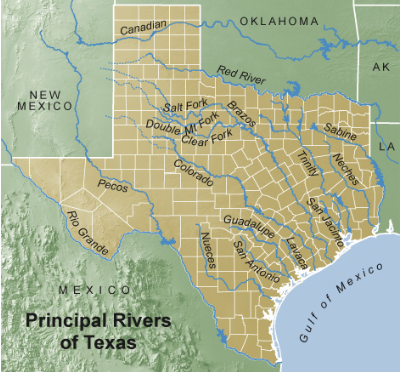Overview
The forks of the Trinity River rise in North Texas north and west of DFW and offer miles of rivers, creeks and lakes to paddle around the DFW area. The West Fork, Clear Fork, Elm Fork, Denton Creek, White Rock Creek, Main Stem and East Fork of the Trinity River offer fun paddling adventures within a short distance of home for North Texans.
Featured Runs & DFW Paddle Trails
Trinity River National Water Trail / Trinity Coalition
Trinity Coalition was primarily responsible for bringing a National Water Trail to DFW in 2021. And they have assembled a special website where DFW paddlers can safely plan their next Trinity canoe or kayak outing. There are maps of paddling trails and tools for interpreting USGS river gauge readings and more.
- West Fork, Trinity River
- Clear Fork, Trinity River
- Elm Fork, Trinity River
- Main Stem Trinity River
- White Rock Creek
- East Fork, Trinity River
Natural Features
Vegetation Areas in the Upper Trinity Basin are Cross Timbers & Prairies in the west, changing to Blackland Prairie as you move downstream on the West Fork into the Main Stem Trinity in Dallas County. As the Trinity meanders southeasterly from Dallas, it passes through Post Oak Savannah in rural East Texas and finally into Gulf Prairies and Marshes as it nears the Gulf of Mexico at Trinity Bay.
Green Ash, Willow, Cottonwood, Pecan, Hackberry, Bois d’arc, Box Elder, Post Oak, Red Oak and Bur Oak are among the dominant trees along the Trinity in the Great Trinity Forest in Dallas County.
The banks of the Trinity in the DFW area are filled with relics of the Pleistocene era. Scientists have unearthed evidence of: ancient camel, ancient bison, armadillo, sloth, saber-tooth cat, mastodon, mammoth, wolf, tapir, turtle, crocodile, eagle, a variety of horses, vole, mink, hare, and others.
Historical / Cultural Significance
The Arkikosa were the indigenous tribe that lived on Galveston Bay and the lower Trinity and San Jacinto rivers in Texas, primarily in the present-day Greater Houston area. They are regarded as a band of the Atakapa Indians, closely related to the Atakapa of Lake Charles, Louisiana.
In 1687, French explorer Robert Cavelier de La Salle initially explored the Trinity River. He named it Riviere des Canoës, which is French for “River of Canoes.” However, the French name didn’t take. In 1690, General Alonzo de Leon named the river La Santisima de la Trinidad, which is Spanish for “The Most Holy Trinity.” In North Texas between the forks of the Trinity, and almost 200 years later, the alleged founding father of Dallas, John Neely Bryan set up shop on the banks of the Trinity. In 1871 and 1872 Bryan became one of the directors of the Dallas Bridge Company, which built the first iron bridge across the Trinity River. Because of serious flooding, after 1910 the Elm Fork and Main Stem were channelized.
Conservation and Threats
Everybody lives downstream. We should all be frequently reminded that the Trinity Basin provides about one half of all Texans’ water supply. Yet rapid growth and urbanization throughout DFW is pushing higher quantities of water and sediment into the Trinity River through increased impervious cover and disturbed surfaces. Excessive amounts of dirt often wash into the river from landscapes that have recently lost their native vegetation and natural cover. Point-source pollution may be entering the Trinity where chemical spills, sewage leaks, and other accidents occur. Non-point source pollution is taking place where pet waste, fertilizers, pesticides, and herbicides are washing off yards and fields into the creeks that feed the river. Fish consumption advisories for the West Fork and Main Stem reflect toxic levels of PCB and Dioxin in large fish tissue.
Fishing
The mainstay of the Trinity fishery is the Channel Catfish. Trinity River Largemouth Bass are more active than their lake brethren; therefore, river bass are smaller but more fun to catch. Bluegill Sunfish and Crappie are fished in the Trinity using worms or small jigs. The large, prehistoric Alligator Gar is a common fish sighted on the Trinity River. The record for Trinity River Alligator Gar is 290 pounds and 96″ in length, caught in 2001. The Alligator gar spawns in flooded bottomlands. When irregular spring flooding of the Trinity River inundates these areas (and temperatures are 68-82F [20-28C]), Alligator gar will move from the main channel into tributary Creeks and branches. In low-lying vegetated areas (up to one mile from main channel), the female Alligator gar will lay eggs and males will fertilize them. A female will lay an average of 150,000 bright red eggs. If ingested, these eggs are poisonous to humans and other predators. The eggs will hatch in as few as 48-72 hours. When the floods subside, fingerlings follow the creeks back to the main channel. For this reason, TPWD regulations allow restriction of Alligator gar fishing in spring or fall flooding conditions. TPWD Alligator Gar Special Restrictions and Reporting.
Additional Resources
- Trinity Coalition
- Trinity River Expeditions
- Trinity River Expeditions (Facebook)
- Trinity River Kayak at Carrollton Dam
- KayakPower.Com Elm Fork Trinity River
- LLELA
- Trinity River Audubon Center
- Trinity River Audubon Center
- Trinity Trails Dallas
- North Texas Whitewater Paddlers
- Adventures Unlimited Paddling Company
- Trinity River Angling Records
- Fish Consumption Advisories Lake Livingston to US 90
- Fish Consumption Advisory Lake Worth
- North Texas River Runners
- Dallas Down River Club
- TPWD Texas Rivers / Streamflow





